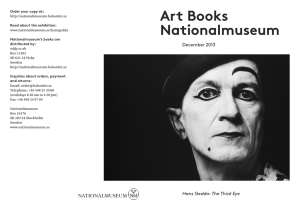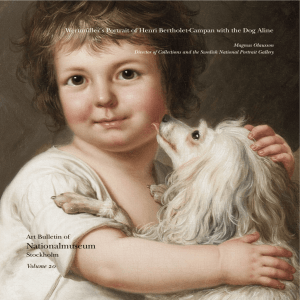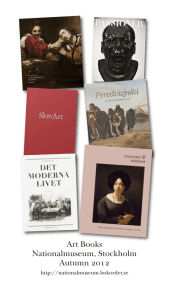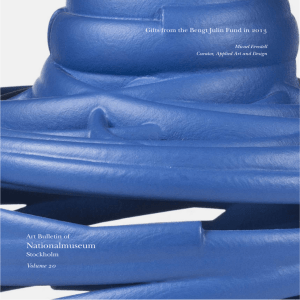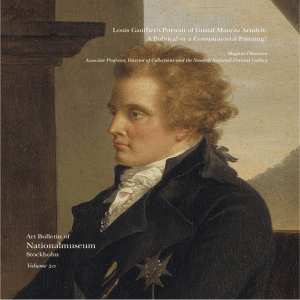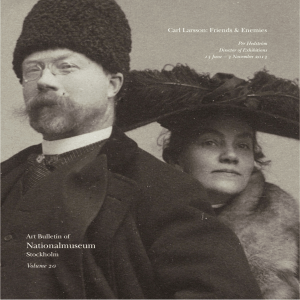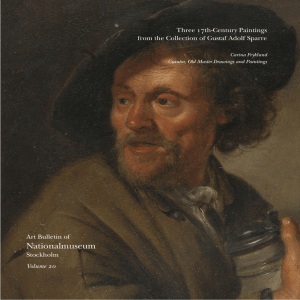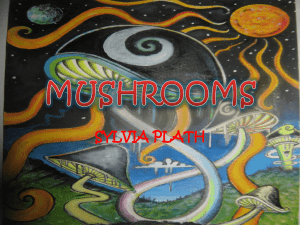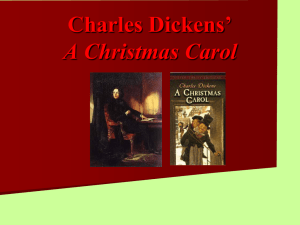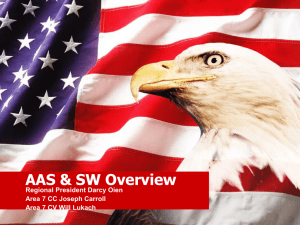Sylvia Stave in the Nationalmuseum
advertisement
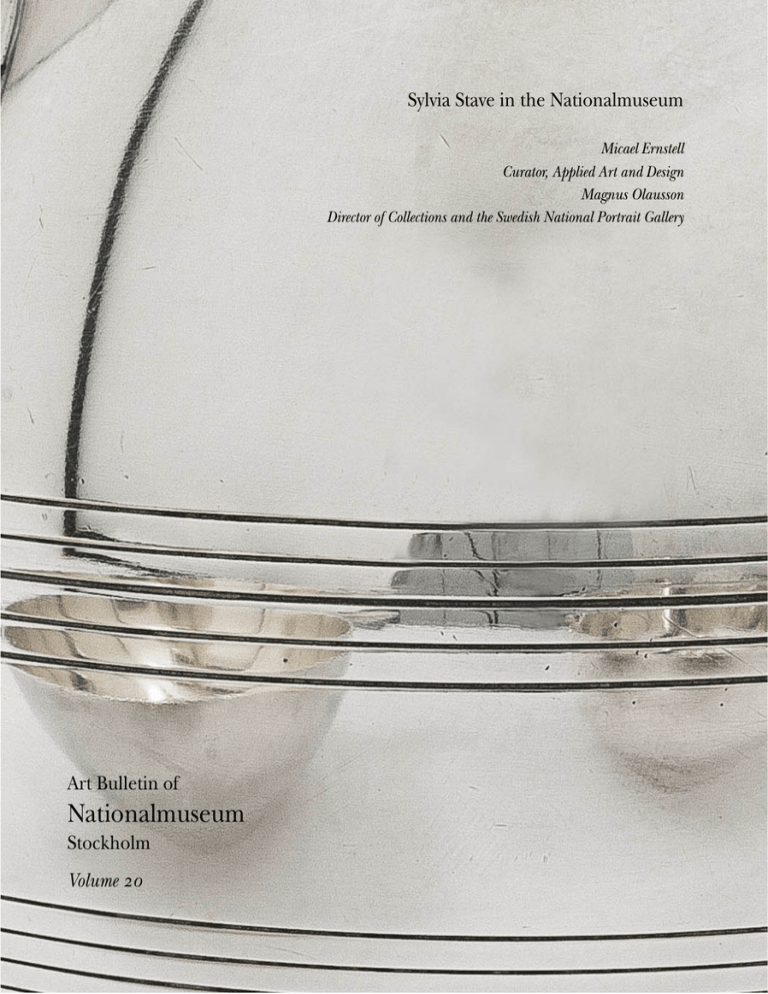
Sylvia Stave in the Nationalmuseum Micael Ernstell Curator, Applied Art and Design Magnus Olausson Director of Collections and the Swedish National Portrait Gallery Art Bulletin of Nationalmuseum Stockholm Volume OM Art Bulletin of Nationalmuseum, Stockholm, is published with generous support from the Friends of the Nationalmuseum. The Nationalmuseum collaborates with Svenska Dagbladet, Fältman & Malmén and Grand Hôtel Stockholm. Items in the Acquisitions section are listed alphabetically by artists’ names, except in the case of applied arts items, which are listed in order of their inventory numbers. Measurements are in centimetres – Height H, Breadth B, Depth D, Length L, Width W, and Diameter Diam. – except for those of drawings and prints, which are given in millimetres. Cover Illustration Alexander Roslin (NTNUÓNTVP), The Artist and his Wife Marie Suzanne Giroust Portraying Henrik Wilhelm Peill, NTST. Oil on canvas, NPN ñ VUKR cm. Donated by the Friends of the Nationalmuseum, Sophia Giesecke Fund, Axel Hirsch Fund and Mr Stefan Persson and Mrs Denise Persson. Nationalmuseum, åã TNQNK Publisher Magdalena Gram Editor Janna Herder Editorial Committee Mikael Ahlund, Magdalena Gram, Janna Herder, Helena Kåberg and Magnus Olausson. Photographs Natinalmuseum Photographic Studio/Linn Ahlgren, Erik Cornelius, Anna Danielsson, Cecilia Heisser, Bodil Karlsson, Per-Åke Persson, Sofia Persson and Hans Thorwid. Picture Editor Rikard Nordström Photo Credits © Herzog Anton Ulrich-Museum, Braunschweig (p. NQ) © The Gothenburg Museum of Art/Hossein Sehatlou (p. NU) © Malmö Art Museum/Andreas Rasmusson (p. OO) © Wildenstein & Co., Inc., New York (p. OV) © RMN Grand Palais/Musée du Louvre, Paris/Hervé Lewandowski (p. PMF © The J. Paul Getty Museum, Los Angeles (Fig. QI p. PN) © RMN Grand Palais/Musée du Louvre, Paris/René-Gabriel Ojéda (Fig. RI p. PN) © Guilhem Scherf (p. PO) © Bridgeman/Institute of Arts, Detroit (p. PP) © Musée des Arts décoratifs, Paris/Jean Tholance (p. PQ) © RMN Grand Palais/Musée du Louvre, Paris (p. PR) © Accademia Nazionale di San Luca, Rome/Mauro Coen (Figs, SI NM and NO, pp. NNQÓNNS) © Mikael Traung (Fig. T, p. NNQ) © Stockholm City Museum (p. NOP) http://www.stockholmskallan.se/Soksida/Post/?n id=319 © Stockholm City Museum/Lennart af Petersens (p. NOQ) © http://www.genealogi.se/component/ mtree/soedermanland/eskilstuna/ a_zetherstroem_/22850?Itemid=604 (p. NOR) © http://www.genealogi.se/component/ mtree/bohuslaen/marstrand/robert-dahlloefsatelier/22851?Itemid=604 (p. NOT) Every effort has been made by the publisher to credit organizations and individuals with regard to the supply of photographs. Please notify the publisher regarding corrections. Graphic Design BIGG Layout Agneta Bervokk Translation and Language Editing Gabriella Berggren and Martin Naylor. Publications Ingrid Lindell (Publications Manager), Janna Herder (Editor). Art Bulletin of Nationalmuseum is published annually and contains articles on the history and theory of art relating to the collections of the Nationalmuseum. Nationalmuseum Box NSNTS ëÉÓNMP OQ Stockholm, Sweden www.nationalmuseum.se © Nationalmuseum and the authors ISSN OMMNJVOPU ~ÅèìáëáíáçåëLëóäîá~ ëí~îÉ áå íÜÉ å~íáçå~äãìëÉìã Sylvia Stave in the Nationalmuseum Micael Ernstell Curator, Applied Art and Design Magnus Olausson Director of Collections and the Swedish National Portrait Gallery p ó ä î á ~ p í ~ î É (NVMUÓNVVQ) is one of the great mysteries of OMth-century design history. Born in Växjö as Sylvia Gadd, she came to Stockholm at the age of ON. By her own account, she went there after running away from her father and stepmother in Kristianstad. This also explains why she quickly adopted the name her mother had taken on remarrying – Stave. She was drawn to Stockholm and the Royal Academy of Fine Arts by strong artistic ambition, although the direct cause was an advertisement placed by the firm of C. G. Hallbergs Guldsmedsaktiebolag, seeking new artistic talent. She submitted samples in the form of drawings, and was taken on. This was in NVOV. The following year, the great Stockholm Exhibition was held. Her contributions to it were a chessboard in pewter and ebony, and an enamelled silver box. The latter was acquired by the Nationalmuseum, and with that her success was assured. Aged just OP, Sylvia Stave became artistic director at C. G. Hallbergs. What training she had and who served as her models, though, remains unclear. Fig. N Sylvia Stave (NVMUÓNVVQ), cocktail shaker. Silver plate. Nationalmuseum, åãâ PRLOMMTK QP Art Bulletin of Nationalmuseum Stockholm Volume OM OMNP ~ÅèìáëáíáçåëLëóäîá~ ëí~îÉ áå íÜÉ å~íáçå~äãìëÉìã Fig. O Sylvia Stave (NVMUÓNVVQ), coffee service. Produced by C. G. Hallbergs, Stockholm NVPMÓNVPQ. Silver plate. Purchase: Barbro Osher Fund. Nationalmuseum, åãâ NTQ~ÓÅLOMNPK In February NVPP, Stave held her first major exhibition. It was in the atrium of the NK department store in Stockholm, and her fellow exhibitors were Folke Arström and Rolf Engströmer, two great names among the designers of the day. The following year she contributed a larger collection of objects in silver and silver plate to Liljevalchs’ Bostad och Bohag (House and Home) exhibition. When Crown Prince Gustav Adolf (later Gustav VI Adolf) purchased an inkwell in connection with the display, her reputation went from strength to strength. In parallel with her successes at home, Art Bulletin of Nationalmuseum Stockholm Volume OM OMNP Stave also exhibited abroad. Along with several other Swedes, she participated in exhibitions in Chicago in NVPP, Leipzig in NVPQÓNVPR and finally Paris in NVPT. Someone who had his eye on Sylvia Stave from early on, and who was directly responsible for the early acquisition of work by her for the Nationalmuseum, was Åke Stavenow. He immediately noticed her distinctive qualities as a designer. Stavenow was fully aware that her ambitions lay, not primarily in mass production, but in a narrow segment of exclusive and artistically avantgarde production of silver and pewter. The QQ vogue material silver plate (electroplated silver), not least, was among those she favoured. Her designs were minimalist and unadorned. Additions in the shape of decorative elements were, it seems, either a concession to Hallbergs or something that was simply tacked on as a selling point. Although the firm’s output was not dominated by objects drawn by Stave, her design work did confer prestige. Various exhibitions, in particular, contributed to this. The forms she presented while at C. G. Hallbergs are marked to a large degree by a sculptural, geometrical idiom. She was ~ÅèìáëáíáçåëLëóäîá~ ëí~îÉ áå íÜÉ å~íáçå~äãìëÉìã Fig. P Sylvia Stave (NVMUÓNVVQ), serving dish with cover. Produced by C. G. Hallbergs, Stockholm NVPMÓNVPQ. Silver plate. Purchase: Barbro Osher Fund. Nationalmuseum, åãâ NVTLOMNPK firmly rooted in her times, found inspiration in the various signals emanating from them, but then went on to offer something entirely unique. The sculptural interplay of surfaces and volumes recalls the Bauhaus school, founded in Germany in NVNV. The latter worked with a vocabulary of form that could be used in both a craft context and industrial mass production. Stave employed the same carefully worked-out, pure and austere idiom. When her work came under scrutiny at the World Exposition in Paris in NVPT, one reviewer spoke of its “elegant simplicity”. She disliked unnecessary deco- ration, although, as we have seen, her designs were sometimes provided with decorative additions when they were made up at Hallbergs. In this new, radical style, the Neue Sachlichkeit, Stave and her contemporaries had found a modern expression that looked to the future and distanced itself from earlier epochs. Sylvia Stave is an enigmatic phenomenon, raising many questions that are difficult to answer. What were her sources of inspiration? The Bauhaus movement was no doubt one of them, although at the end of her life she herself denied this. QR In NVPT, Stave participated in an exhibition of Nyttokonst (Useful Art) at the Nationalmuseum, together with a number of fellow designers, but quite clearly as a representative of C. G. Hallbergs. The same was true of the World Expo in Paris that year. There, in what would prove a turning point in her career, she showed a series of works in silver. Evidently, she now wanted to try her wings internationally, having felt obstructed, as a young woman, by superiors and colleagues alike. A conflict with Folke Arström over a question of authorship was no doubt a contributory factor. Arström accused Art Bulletin of Nationalmuseum Stockholm Volume OM OMNP ~ÅèìáëáíáçåëLëóäîá~ ëí~îÉ áå íÜÉ å~íáçå~äãìëÉìã Fig. R Sylvia Stave (NVMUÓNVVQ), water jug. Produced by C. G. Hallbergs, Stockholm NVPMÓNVPQ. Silver plate. Purchase: Barbro Osher Fund. Nationalmuseum, åãâ NVULOMNPK Fig. Q Sylvia Stave (NVMUÓNVVQ), water jug. Produced by C. G. Hallbergs, Stockholm NVPMÓNVPQ. Silver plate. Purchase: Barbro Osher Fund. Nationalmuseum, åãâ NUNLOMNPK Stave of having stolen his work in her design for the royal tennis cup, which was won by the superstar of the day, Jean Borotra. When she applied to and was accepted by the École des Beaux-Arts in Paris, it was in answer to a desire for both artistic and personal development. The management of C. G. Hallbergs Guldsmedsaktiebolag were furious, clearly knowing nothing of her French plans. After a year in Paris, Stave returned home to design the NVPV collection, but would not stay long. She had now met her husband-to-be, the doctor René Agid, whom she married in NVQM. At the age of PN she gave up a flourishing career, never again to turn her hand to design. Sylvia Stave became a housewife and died in Paris in NVVQ. The revival of interest in Stave internationally is linked to Alessi, who in NVUV began manufacturing a variant in stainless steel of her jugs and cocktail shakers. The Alessi shaker has different proportions and lacks the braided rattan handle of the originals. It was launched as a design of one of the great names of the Bauhaus movement, Marianne Brandt. The German-Swedish collector Rolf Walter however, who had rediscovered Stave in the NVUMs and started collecting her work, was able to correct this misattribution. Today, the cocktail shaker is mar- Art Bulletin of Nationalmuseum Stockholm Volume OM OMNP QS keted by Alessi as a design of Sylvia Stave. Close contact with Walter resulted in his selling a shaker to the Nationalmuseum in OMMT (Fig. N), drawn from his unique collection. Now, thanks to the Barbro Osher Fund, the Museum has been able to acquire the whole of Rolf Walter’s collection of QM items in all (Figs. OÓR). These objects demonstrate the high quality of Stave’s short but intense career as one of the fixed stars of the interwar years. She is to be the subject of both book and exhibition projects at the Nationalmuseum in the near future.
